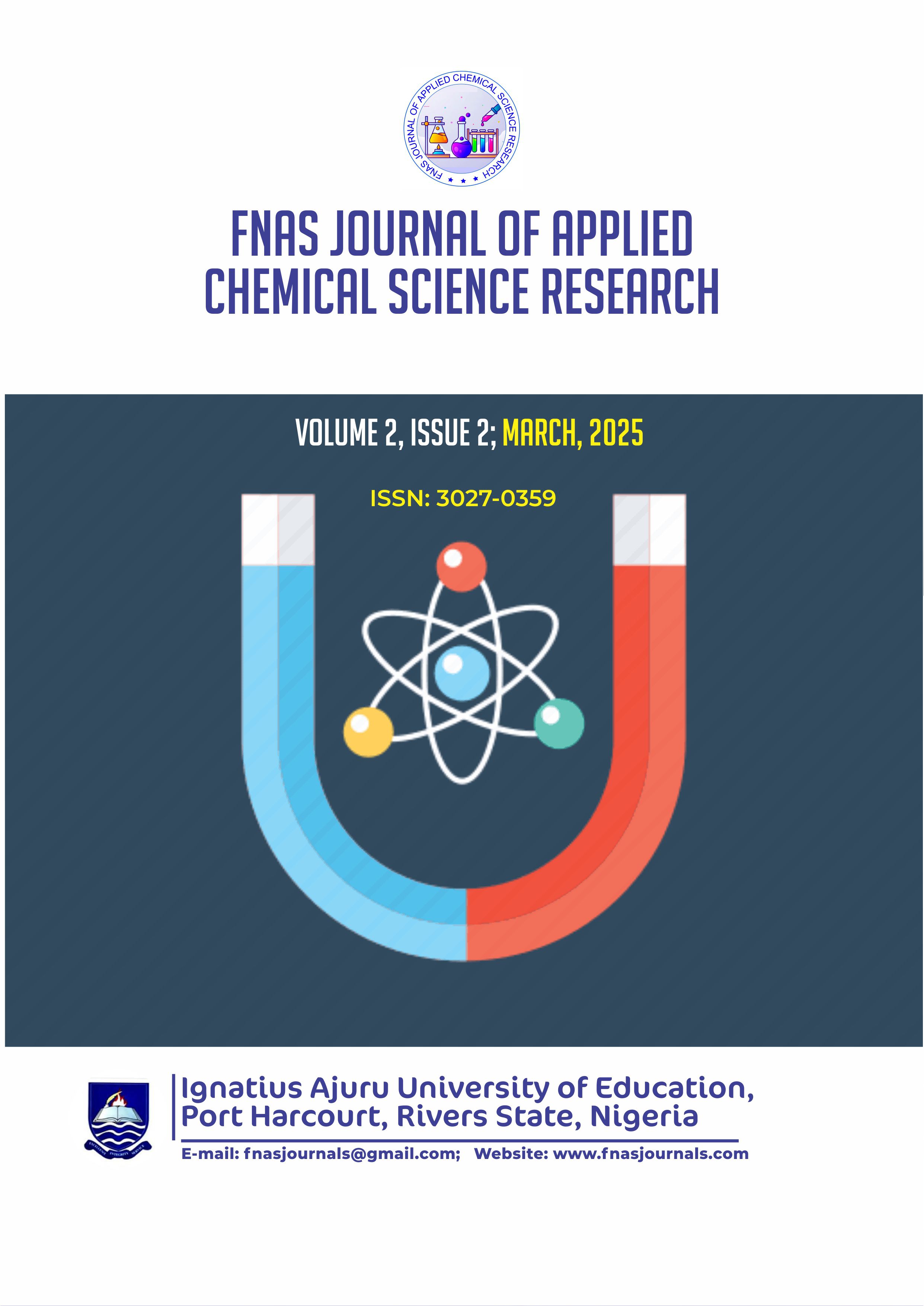Salt Content of Selected Legume-Based Foods Sold in Different Restaurants in Nsukka, Enugu State
Keywords:
Salt Content, Legume-Based Foods, Food Analysis, Restaurant Foods, NutritionAbstract
Salt is an important food condiment that serves as a flavor enhancer, preservative, seasoning agent, enzyme inhibitor, and tenderizer. According to the World Health Organization, the recommended daily salt intake for an individual is less than 5 grams. In this study, samples of some legume-based foods namely akara, achicha, and akidi with abacha were collected from three different restaurants in Nsukka, Enugu State and the salt content of each food sample was analysed. During analysis, one gram of each sample was weighed out and digested with aqua regia, a mixture of nitric acid and hydrochloric acid in the ratio of 1:3. After digestion, the sodium content of the food samples was determined using an atomic absorption spectrophotometer. The results of the investigation and analyses showed that the salt concentrations of the samples of the legume-based foods were between 7.8 grams and 8.4 grams. The mean values of the salt content in every 100 grams of these food samples were higher than the recommended daily intake and this could be very detrimental to human health. Hence, this study recommends an urgent need for the reduction of dietary salt intake in the preparation of these legume-based foods to curtail the health challenges associated with excess salt intake.
References
Adrogué, H. J., Tucker, B. M., & Madias, N. E. (2022). Diagnosis and Management of Hyponatremia: A Review. JAMA, 328(3), 280. https://doi.org/10.1001/jama.2022.11176
Al Jawaldeh, A., & Al-Khamaiseh, M. (2018). Assessment of salt concentration in bread commonly consumed in the Eastern Mediterranean Region. Eastern Mediterranean Health Journal = La Revue De Sante De La Mediterranee Orientale = Al-Majallah Al-Sihhiyah Li-Sharq Al-Mutawassit, 24(1), 18–24.
Applegate, C. C., Rowles, J. L., Ranard, K. M., Jeon, S., & Erdman, J. W. (2018). Soy Consumption and the Risk of Prostate Cancer: An Updated Systematic Review and Meta-Analysis. Nutrients, 10(1), 40. https://doi.org/10.3390/nu10010040
Archer, N. S., Cochet-Broch, M., Mihnea, M., Garrido-Bañuelos, G., Lopez-Sanchez, P., Lundin, L., & Frank, D. (2022). Sodium Reduction in Bouillon: Targeting a Food Staple to Reduce Hypertension in Sub-saharan Africa. Frontiers in Nutrition, 9, 746018. https://doi.org/10.3389/fnut.2022.746018
Becerra-Tomás, N., Papandreou, C., & Salas-Salvadó, J. (2019). Legume Consumption and Cardiometabolic Health. Advances in Nutrition, 10, S437–S450. https://doi.org/10.1093/advances/nmz003
Bernal, A., Zafra, M. A., Simón, M. J., & Mahía, J. (2023). Sodium Homeostasis, a Balance Necessary for Life. Nutrients, 15(2), 395. https://doi.org/10.3390/nu15020395
Darragh-Hickey, C., Flowers, K. C., Shipman, A. R., Allen, G. T., Kaur, S., & Shipman, K. E. (2022). Investigative algorithms for disorders affecting plasma chloride: A narrative review. Journal of Laboratory and Precision Medicine, 7, 22–22. https://doi.org/10.21037/jlpm-22-7
De Vasconcellos, K., & Skinner, D. L. (2018). Hyperchloraemia is associated with acute kidney injury and mortality in the critically ill: A retrospective observational study in a multidisciplinary intensive care unit. Journal of Critical Care, 45, 45–51. https://doi.org/10.1016/j.jcrc.2018.01.019
Didinger, C., & Thompson, H. J. (2022). The role of pulses in improving human health: A review. Legume Science, 4(4), e147. https://doi.org/10.1002/leg3.147
DiNicolantonio, J. J., & O’Keefe, J. H. (2023). Sodium restriction and insulin resistance: A review of 23 clinical trials. Journal of Metabolic Health, 6(1). https://doi.org/10.4102/jir.v6i1.78
Elias, M., Laranjo, M., Cristina Agulheiro-Santos, A., & Eduarda Potes, M. (2020). The Role of Salt on Food and Human Health. In M. Cengiz Çinku & S. Karabulut (Eds.), Salt in the Earth. IntechOpen. https://doi.org/10.5772/intechopen.86905
Grant, G. (2017). Hypertension. Global Journal of Addiction & Rehabilitation Medicine, 2(4). https://doi.org/10.19080/GJARM.2017.02.555591
Graudal, N. A., Hubeck-Graudal, T., & Jurgens, G. (2017). Effects of low sodium diet versus high sodium diet on blood pressure, renin, aldosterone, catecholamines, cholesterol, and triglyceride. Cochrane Database of Systematic Reviews. https://doi.org/10.1002/14651858.CD004022.pub4
He, F. J., & MacGregor, G. A. (2018). Role of salt intake in prevention of cardiovascular disease: Controversies and challenges. Nature Reviews. Cardiology, 15(6), 371–377. https://doi.org/10.1038/s41569-018-0004-1
Hughes, J., Pearson, E., & Grafenauer, S. (2022). Legumes—A Comprehensive Exploration of Global Food-Based Dietary Guidelines and Consumption. Nutrients, 14(15), 3080. https://doi.org/10.3390/nu14153080
Itoh, N., Tsuya, A., Togashi, H., Kimura, H., Konta, T., Nemoto, K., Yamashita, H., & Kayama, T. (2022). Increased salt intake is associated with diabetes and characteristic dietary habits: A community-based cross-sectional study in Japan. Journal of Clinical Biochemistry and Nutrition, 71(2), 143–150. https://doi.org/10.3164/jcbn.21-153
Larsen, B. R., Stoica, A., & MacAulay, N. (2016). Managing Brain Extracellular K+ during Neuronal Activity: The Physiological Role of the Na+/K+-ATPase Subunit Isoforms. Frontiers in Physiology, 7. https://doi.org/10.3389/fphys.2016.00141
Martinsen, T. C., Fossmark, R., & Waldum, H. L. (2019). The Phylogeny and Biological Function of Gastric Juice-Microbiological Consequences of Removing Gastric Acid. International Journal of Molecular Sciences, 20(23), 6031. https://doi.org/10.3390/ijms20236031
Mlyneková, Z., Chrenková, M., & Formelová, Z. (2016). Cereals and Legumes in Nutrition of People with Celiac Disease. International Journal of Celiac Disease, 2(3), 105–109. https://doi.org/10.12691/ijcd-2-3-3
Muntner, P., Shimbo, D., Carey, R. M., Charleston, J. B., Gaillard, T., Misra, S., Myers, M. G., Ogedegbe, G., Schwartz, J. E., Townsend, R. R., Urbina, E. M., Viera, A. J., White, W. B., Wright, J. T., & on behalf of the American Heart Association Council on Hypertension; Council on Cardiovascular Disease in the Young; Council on Cardiovascular and Stroke Nursing; Council on Cardiovascular Radiology and Intervention; Council on Clinical Cardiology; and Council on Quality of Care and Outcomes Research. (2019). Measurement of Blood Pressure in Humans: A Scientific Statement from the American Heart Association. Hypertension, 73(5). https://doi.org/10.1161/HYP.0000000000000087
Ojo, A. E., Alfa, V. O., Huffman, M. D., & Ojji, D. B. (2024). Nigeria sodium study 2023 policy meeting on dietary sodium reduction in Nigeria. BMC Proceedings, 18(S16), 18. https://doi.org/10.1186/s12919-024-00303-3
Siddiq, M., & Uebersax, M. A. (Eds.). (2022). Dry beans and pulses: Production, processing, and nutrition (Second edition). Wiley Blackwell.
Yorgancilar, M., & Bilgiçli, N. (2014). Chemical and nutritional changes in bitter and sweet lupin seeds (Lupinus albus L.) during bulgur production. Journal of Food Science and Technology, 51(7), 1384–1389. https://doi.org/10.1007/s13197-012-0640-0
Yuyun, M. F., Sliwa, K., Kengne, A. P., Mocumbi, A. O., & Bukhman, G. (2020). Cardiovascular Diseases in Sub-Saharan Africa Compared to High-Income Countries: An Epidemiological Perspective. Global Heart, 15(1), 15. https://doi.org/10.5334/gh.403


